 |
|

|
|

|
 |
TABLE of CONTENTS
 |
Aeronautics staff encourage pilots from around-the-world to #fly.MN at annual aviation convention |
By Mary McFarland Brooks
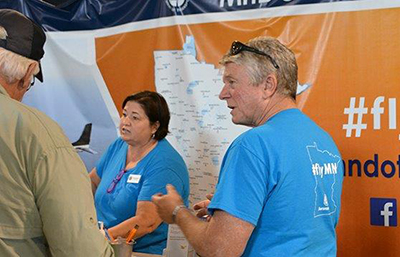
Darlene Dahlseide and Brian Conklin, Aeronautics staff, spoke with a visitor at MnDOTís booth at Oshkosh AirVenture 2016. Photo by Mary McFarland Brooks |
More than 563,000 aviation enthusiasts, including Office of Aeronautics staff, descended on Oshkosh, Wis., the last week of July for the Experimental Aircraft Association’s 64th annual EAA AirVenture fly-in convention.
MnDOT hosted a booth using the theme of #fly.MN to encourage fly-in participants to visit Minnesota’s airports. Booth visitors, which numbered several hundred daily, also had the opportunity to get their photos taken with “Paul Bunyan” and his blue ox, “Babe.” Photos taken at the aeronautics booth were shared daily on MnDOT’s Instagram and Facebook sites.
Several of the airport managers from Minnesota also volunteered at the booth and spoke with visitors about the recreational opportunities available in their areas. One airport staffer later reported that several pilots stopped by an adjacent town to buy fuel or spend the night on the way home from the fly-in.
In addition to hosting a booth, Aeronautics staff participated in technical forums on a wide array of aviation issues. Staff also recruited new businesses to exhibit and speak at the annual spring maintenance conference MnDOT hosts in partnership with the Association for Women in Aviation Maintenance.
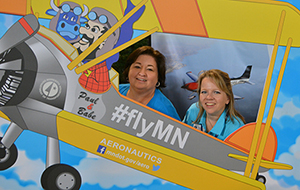
Darlene Dahlseide and Cassandra Isackson, Aeronautics staff, demonstrated the opportunity for visitors to get their photo with “Paul Bunyan” and his blue ox, “Babe” at MnDOT’s booth at Oshkosh AirVenture 2016. Photo by Mary McFarland Brooks |
Cassandra Isackson, Aeronautics director, and Kathy Vesely, assistant director, were part of a panel where they discussed “Airport Funding 101-the Minnesota Experience.”
“We met with other states’ aeronautics staff and Federal Aviation Association officials to discuss the upcoming federal reauthorization bill as well as the hot topic of the day, drones. Overall we had a very successful event,” Isackson said.
An appearance by the Canadian Forces Snowbirds demonstration squadron was a highlight of the event. The number of show planes at the event increased 7 percent from last year to a total of 2,855, while vintage airplanes at EAA grew by the same percentage to 1,032.
The fly-in has significant international reach with more than 80 nations represented. The countries with the most visitors included Canada, Australia and Argentina. The total number of international visitors was more than 2,369, excluding the 750 media representatives on-site from six continents.
The 2017 fly-in will celebrate the 80th anniversary of the Piper Cub airplane and the 70th anniversary of the U.S. Air Force. |
 |
|

|
 |
TABLE of CONTENTS
 |
Metro District employee eligible for vacation donation |
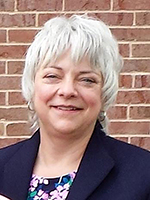
Paula Erickson, Metro District, was diagnosed with cancer and is eligible for the vacation donation program. Photo courtesy of Metro District |
Paula Erikson, business manager in the Metro District, is now eligible for the state vacation donation program.
After having been diagnosed with life-threatening cancer, she has exhausted more than 400 hours of vacation and sick leave.
“It is hard to find the right words to thank everyone for their continued support, prayers and well wishes. Thank you in advance for your contributions,” Erickson said.
Currently receiving chemotherapy, she will later require surgery and radiation.
To donate vacation hours, go to the Employee Self Service Web site and click “Other Payroll” and then “Leave Donations.” The site also allows employees to view a list of all state employees eligible for the program and to enroll as a recipient. |
 |
|

|
 |
TABLE of CONTENTS
 |
Resource management helps agency connect strategic vision to operational goals |
|
By Pat Enderson, Commissionerís Office
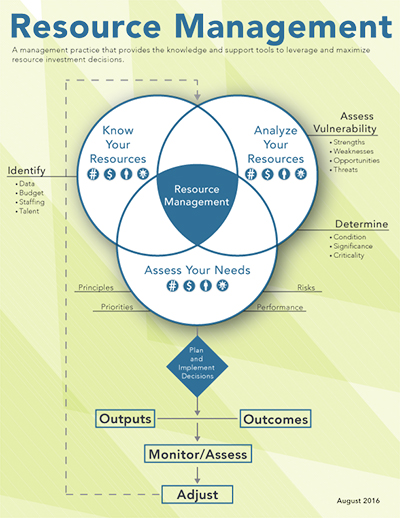
During the past few months, MnDOT senior leaders have participated in guided exercises with the Resource Management Unit to help identify strategies to make more informed and nimble resource investment decisions. This illustration shows the elements involved in resource management planning. Graphic by Libby Schultz |
How does MnDOT connect its mission and long-term vision to day-to-day business?
This is done by strategically planning for the future and creating solid operational plans to ensure delivery on key objectives. An important unit helping to make this happen is Resource Management.
“Resource management is about using our resources in the most efficient way possible. This includes use across the agency as well as at the office and district level,” said Sue Stein, Corporate Services assistant commissioner.
Judy Schmidt, program director, leads the Resource Management Unit, which is tasked with developing best practice frameworks and tools for strategic direction setting, strategic staffing, common budget reporting and business planning.
“These management practices provide the knowledge and decision-support tools to leverage and maximize operating budget investment decisions,” said Schmidt. “We are fortunate to be working cross-functionally with MnDOT’s HR, Finance, Administration, Technology Investment Management, and Transportation System Management offices, as well as outside partners to develop and implement these new tools.”
The past several months has focused on transitioning a resource management framework from the Operations Division to an agency-wide framework and implementation plan. Essential to the process was interviewing all MnDOT senior leaders, including office directors, district engineers, assistant commissioners, chief of staff, chief counsel, assistant division directors, deputy commissioners and commissioner.
“The information gleaned from those interviews continues to guide our work today,” said Schmidt.
“The proactive approach and time spent on resource planning and management efforts in the Operations Division has paid great dividends and was undoubtedly a great investment of our time,” said Emma Corrie, Operations business manager.
Some direct benefits she noted include:
- District engineers and office directors are now intimately familiar with their numbers, both for budgets and people
- Technical experts, business staff and leadership worked closely together to develop various budget and staffing strategies
- The identified strategies will enable better informed decision-making at all levels
- Using a coordinated approach ties MnDOT vision, mission and strategic priorities to everyday investment decisions
Currently, Resource Management is partnering with the Performance, Risk and Investment Analysis Unit in the Office of Transportation System Management to guide districts and offices through strategic direction-setting meetings. These meetings give division leadership teams an opportunity to identify operational goals and strategies that respond to transportation trends and existing long-range planning objectives. Senior leadership will use this input to create a new five-year strategic operating plan for the agency. The need for this new planning document was expressed during the interviews conducted earlier this year.
“This strategic operating plan is the first step in creating a base for districts and offices to create, implement and manage business plans that work toward one cohesive vision,” said Schmidt. “While using this five-year plan as a base, districts and offices will focus on aligning their operational goals with the overall agency goals and making decisions accordingly.”
Resource Management is also holding division meetings to focus on staffing strategically. The strategic staffing process defines and addresses staffing and skill implications of strategic and operational goals. Resource Management assists the districts and offices in creating a staffing plan for the future that also informs current staffing decisions.
Resource Management is taking best practices from around the agency to build a common set of tools. These tools allow all districts and offices to create business plans that encompass their strategies.
“These are tools and processes that let decision-makers manage their organizations with valuable data in order to make strategic operating decisions,” Schmidt said.
The objective is to have all districts and offices using the same tools to deliver key outputs that support agency goals and operational strategies going forward.
“By using a common set of tools and processes, MnDOT will be better situated to plan for and implement thoughtful, short-term decisions based on longer-term strategies,” Stein said, “and employees will be better able to see how their day-to-day work connects to the agency’s mission and vision.”
For more information, visit the Resource Management site or email the Resource Management team. |
 |
|

|
 |
TABLE of CONTENTS
 |
Aeronautics presents summer aerospace workshop for teachers |
By Mary McFarland Brooks
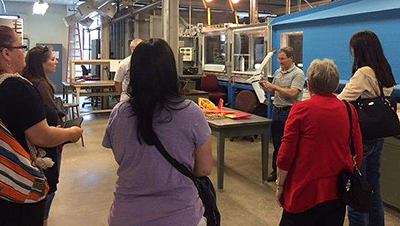
During the Aeronautics workshop, teachers visited the University of Minnesota Aerospace Engineering Wind Tunnel lab with professor James Flaten. Photo courtesy of Aeronautics |
The study of aeronautics lends itself to the classroom in a big way.
Using science, technology, engineering and math, known as STEM, and including history and language arts, teachers introduce the many facets of flight to their students. One of the tactics the Office of Aeronautics uses to introduce these principles is the Summer Aerospace Workshop for Teachers, where for eight years MnDOT’s Darlene Dahlseide has trained kindergarten – 8th grade teachers to integrate the study of aeronautics into their classrooms.
“In today’s fast-paced world, it is essential that MnDOT offers these workshops for teachers to help them with the tools they need to get students excited about careers in aviation,” Dahlseide said.
Teachers who attended the 2016 workshop held at the Aeronautics office represented these elementary schools:
- Garlough Environmental Magnet, West St. Paul
- St. Jerome’s School, St. Paul
- Association of French Schools, St. Louis Park
- Farmington School District 192
- Sibley East, Arlington
- University Avenue Elementary-Aerospace, Children’s Engineering & Science, Blaine
Rachel Obermoller, MnDOT aviation representative, and Eileen Johansen, Farnworth Aerospace Magnet teacher, also presented at the workshop and explored uses for the Science of Flight kit the teachers receive to use in the classroom.
One of the exercises Johansen taught was creating paper airplanes to illustrate the principles of lift, weight, thrust and drag in flight. She stressed to the teachers that the application of aeronautics principles in the classroom is broad and deep and can be tailored to the students’ comprehension level.
“Aviation combines technology with a hands-on approach for teachers to use in their classrooms. Children are enthusiastic learners and they learn the steps of engineering that help them work together to solve problems,” said Johansen. “Aviation is a great way for teachers to do STEM in their classroom and the 2016 workshop group of teachers was very enthusiastic. Their enthusiasm will be matched by the students in their classrooms during the coming year.”
The teachers had various reasons for attending the training, ranging from responsibility for writing STEM lessons and curricula to the need to accrue credits and general staff development. All of the teachers reported taking away from the workshop much more than they anticipated.
One of the teachers said she will teach an after-school class during the school year using the information that was presented. She wrote in her workshop summary, “Thank you so much. I am looking forward to sharing this experience with my students and school.”
Another teacher appreciated the Science of Flight kit materials she received at the workshop. She wrote, “I strive to share my passion about learning with my students, and the tools in the kit, the new ideas from Eileen Johansen and the professionals from MnDOT made my year!”
There was general excitement and enthusiasm from the teachers at the four-day workshop as they increased their knowledge of how to teach the principles of flight and received hands-on activities and ideas to enhance their students’ learning experience. Along with curriculum ideas, the kits included locations for aviation field trips and local and national resources to support student interest in the aviation industry.
MnDOT’s aeronautics staff also provided information about aviation careers, including aviation management, aircraft manufacturing, and airline and airport operations. They also talked about career paths for pilots, aircraft maintenance technicians and traffic controllers. More information about aviation education can be found at: www.mndot.gov/aero/aviationeducation/index.html.
Aviation education for high school students
Aeronautics staff is also available to provide classroom presentations during the year on:
- Skills necessary to be successful in aviation careers
- History and principles of flight, which takes students through the inception of flight to the space exploration of today
The workshop and classroom presentations are augmented by MnDOT’s partnership with the Federal Aviation Administration, which co-sponsors the Aviation Career Education camp for students entering their sophomore through senior years of high school. The camp helps students explore a variety of aviation careers and all aspects of the aviation and aerospace industries by tours and hands-on projects.
Students have the opportunity to fly in a helicopter, pilot a single-engine aircraft and take the controls of a glider. Volunteers from within the aviation community, including pilots, air traffic controllers, military personnel and students in college aviation programs, staff the camp.
Aeronautics directs efforts in aviation education at high school age students because measurement of the number of students choosing aviation careers is easier to track when students are ready to identify colleges and universities for advanced training and exploring internships related to aviation careers.
“Aeronautics is evaluating all of its aviation education activities. We recently contracted with the Minnesota Management and Budget agency to conduct interviews with aviation businesses, educators and government agencies to aid us in strategic planning going forward,” said Cassandra Isackson, Aeronautics director. |
 |
|

|
 |
TABLE of CONTENTS
 |
Employees have online access to ASTM standards and select AASHTO publications |

The ASTM Compass gives MnDOT employees online access to ASTM standards and select AASHTO publications. |
MnDOT employees now have online access to the American Society for Testing and Materials standards and select American Association of State Highway and Transportation Officials publications. The new portal, called ASTM DOT Compass, is available for all employees.
“Many engineers and other staff have been waiting for a tool like the ASTM DOT Compass Portal” said Marilee Tuite, Research Services and Library. “For example, the MnDOT Spec Book makes passing references to these standards more than 450 times. The portal will save time and improve efficiency because employees can quickly locate the current full text of the digital standard, which wasn’t the case before the portal subscription.”
An example of a reference to a standard is: do this “in accordance with AASHTO T71” or continue this “as determined by ASTM D4792.”
Full-text access works via IP recognition and individual sign-in:
- Go to http://compass.astm.org
- If prompted, click on the yellow box to agree with the license.
- Sign in. If this is your first visit, you will need to do a one-time registration of a username (your MnDOT e-mail) and a password (at least six characters, only letters and numbers).
This iHub page contains helpful information about using the portal, including a recorded training specific to MnDOT’s subscription and brief demo videos for each feature: http://ihub/library/ASTM-Portal.html.
The one-year access to the portal is made possible by funding from a research implementation project. This project will evaluate the usefulness of the portal and help determine if it will be renewed.
If you have any questions or need guidance using the portal, contact MnDOT Library at library.dot@state.mn.us, 651-366-3791, or via www.dot.state.mn.us/library/asklibrarian.html. |
 |
|

|
 |
TABLE of CONTENTS
 |
Linear Referencing System replaces TIS |
Now that the Transportation Information System has been shut down, how can someone access and work with its replacement - the Linear Referencing System?
Most people outside of Office of Transportation System Management/Transportation Data Analysis will not work directly with the LRS. The LRS is a transactional environment, meaning data is actively edited and maintained. Most people will interact with the resulting data either through the new Spatial Data Warehouse or within an application.
In the case of an application, there will be a copy of the required LRS data copied into an application specific database. Application users will access these application specific databases to link to just that information that they need.
With the new system, applications using TIS or BaseMap data will require modifications. Everyone affected is encouraged to discuss modifications with MnIT staff as soon as possible. A key part of modifying affected applications will be to determine specifically what LRS data is needed by each application. The more work business areas needing applications modified can do to prepare that list in advance, the faster the migration can occur. Business staff who will be working on an application migration should begin by reviewing the LRS iHub page. This will provide some context and definition for the questions that IT will be asking as part of an application update.
Ad-hoc reporting and mapping of the LRS data will be available through the new Spatial Data Warehouse. Access to the new SDW will be provided on an individual basis through use of an AD account name. The SDW will have copies of the LRS data both with and without measures attached. To just view the Roadway Characteristics data (Surface width/type, Shoulder Info, Control Sections, etc.) non-measured data should suffice. To map data against the routes or merge data together in a tabular view, the measures are needed.
Initially, access to the SDW will be limited to the non-measured data. Anyone who wants access to the measured data should review the LRS iHub page. There is a lot of information there that can help reduce the risk of corrupting data by mixing TIS and LRS data.
Please contact Peter Morey 651-366-3872 with any questions. |
 |
|

|
 |
TABLE of CONTENTS
 |
Minnesota, North Dakota receive joint transportation award |
By Rich Kemp

The Sorlie Bridge that spans the Red River between East Grand Forks and Grand Forks, N.D. has added LED lights during a construction project that was completed in October 2015. Photo courtesy of the North Dakota Department of Transportation |
Every year, the American Association of State Highway and Transportation Officials, AAA, and the U.S. Chamber of Commerce recognize the best transportation projects across America and highlight the benefits they provide to communities throughout the country.
In a joint collaboration between the North Dakota and Minnesota department of transportations, the Sorlie Bridge project this year received an American’s Transportation Award.
“It is good recognition for historic bridge preservation and good partnering with North Dakota,” said Nancy Daubenberger, assistant commissioner, Engineering Services division. “By working together, the agencies were able to save taxpayer dollars.”
Through inter-agency collaboration and community outreach, officials from the two state agencies saved $24 million by rehabilitating this critical bridge and adding several safety and aesthetics features, such as paint and LED lighting to preserve its rich history.
The $4.6 million project rehabilitated an aging bridge across the Red River to increase safety and maintain connectivity between the cities of East Grand Forks and Grand Forks, N.D. During the construction phase, crews kept the bridge open to traffic to maintain the flow of 14,000 vehicles daily and reduce impacts to the traveling public. |
 |
|

|
 |
TABLE of CONTENTS
 |
MnDOT team competes in the 2016 National Bike Challenge |
By Dana Hernandez

Before gearing up for a ride Dave Cowan, Amber Dallman, Michael Petesch and Liz Walton stand by their bikes. The Transit Office employees are participating in the National Bike Challenge. Photo by Dana Hernandez |
MnDOT employees are once again participating in the National Bike Challenge, which is in its fifth year. This year’s challenge runs from May 1 through Sept. 30, so there is still time for MnDOT bicyclists to sign up.
The event is intended to encourage bicyclists of all skill levels to bike more, whether it is for recreation, transportation, economic or environmental reasons. By allowing participants to join teams and by tracking how many miles are ridden, bicyclists are ranked within their own groups and nation-wide, creating a fun and friendly competition with their friends, coworkers and community members.
Some of MnDOT’s participants active in the challenge this round are Mike Schadauer, Liz Walton, Jim Nelson, Luke Van Santen, Jim DeLuca, Jeff Buschette, Philip Schaffner, Peter Dahlberg, Garret Schreiner, Renee Barnes and Michelle Musser-Pooler.
Buschette, from District 4, has a passion for biking and rides recreationally and to work once or twice a week. He said participating in the challenge not only promotes bicycling to the public, but inspires him to put in more miles. Apart from the MnDOT team, he is a part of Lakes Area Bike Club, where they always make sure to eat first, bike after, he says, and a group called Cutters for a Cure, which raises awareness and funds to find a cure for multiple sclerosis. His favorite place to bike is Lakes Country.
Van Santen and Walton have participated in the event for a couple of years and each of them bike mostly for transportation purposes.
“Commuting and running errands on a bike is much more fun than being stuck bumper-to-bumper on the freeway,” Walton said.
She also goes on bicycle trips during the year, such as her recent one in the Rocky Mountains.
So far MnDOT participants, from Detroit Lakes, Minneapolis, St. Paul, Sartell and Wayzata, have burned 704,617 calories, saved $4,019 from transportation costs and 6,402 pounds of carbon dioxide.
MnDOT has taken part for the last two years and is enrolled with other state agencies. New to the event this year, MnDOT employees are a part of a larger challenge group, The State of Minnesota Employees. Some of the other agencies participating include Metropolitan Council, DNR, and PCA. The 150 riders for this group are currently ranked 18th for workplaces in the nation.
Van Santen takes part in the challenge because “it is fun to be part of a larger community and to demonstrate that it is possible to bike for transportation, and it is motivational.” Of the many participants, he says, “I think it speaks well of the commitment MnDOT and its employees have to making a truly multi-modal transportation system in Minnesota.”
Like MnDOT, the creators of the National Bike Challenge support and promote bicycle safety. The challenge website features safety topics such as following traffic laws, being predictable and conspicuous, thinking ahead and riding ready.
Read more details at the MnDOT bicycle and Share the Road web pages. |
 |
|

|
 |
TABLE of CONTENTS
 |
We are all pedestrians |
By Melissa Barnes, state pedestrian and bicycle safety engineer

Melissa Barnes, state pedestrian and bicycle safety engineer, says that we are all responsible for pedestrian safety and that every pedestrian matters. Photo by Judy Jacobs |
As mother of three young boys, I’m well aware of my responsibility of making sure they are safe. Each day, I do countless things to protect them. When we cross the street, we hold hands and I tell them to look both ways for cars. I hope to instill in them as they grow older that crossing the street safely is their responsibility. And when they begin to drive, they will learn that driving safely is their responsibility too.
As we are probably all aware, pedestrian crashes are increasing in Minnesota. Lives are being lost. In Minneapolis and St. Paul, a pedestrian is hit about every other day. These pedestrians are children, fathers, mothers, brothers, sisters and friends.
The troubling part is that we’re all pedestrians at some point in our day. Let me repeat that: we are all pedestrians at some point in our day. The pedestrian causing you to slow down or stop was you five minutes ago as you walked from your car into work or into the store. Somehow, in our hurried lives and schedules, we aren’t patient anymore. We are distracted. We want to roll through the stop sign. We want to cross the street even though the signal hasn’t cleared us to go. We want to drive five or 10 miles faster than the posted speed limit. Updating our Facebook status just can’t seem to wait. We forget our responsibility to be safe and people are paying with their lives.
When a pedestrian and vehicle collide, statistics show that half the time it’s the pedestrian’s fault and the other half, it’s the driver’s fault. We are all responsible for pedestrian safety, whether we are pedestrians or drivers.
MnDOT tells people time and time again, in our messaging, to scan the road and watch for pedestrians, to not drive or walk distracted, to obey signals, to make eye contact with drivers, to slow down. In spite of all we do and will continue to do, in terms of better engineering, better education, more enforcement and better emergency medical services, people - children, fathers, mothers, brothers, sisters and friends - are still getting hit and suffering life-changing injuries or dying.
The mother and adult daughter who crossed the street together will never do that together again because the daughter was killed. The teen who was hit by a turning bus will deal with his injuries every day for the rest of his life. The young woman who was tossed 30 feet down the road after being hit has recovered from four broken pelvic bones and a concussion, but now has short-term memory issues.
These injuries and deaths affect so many lives, from the people who were walking with them, to the drivers, to the families of all involved in the crash. When I think of the thousands of people affected by these crashes every year, I am reminded of the importance of paying attention and following the laws.
It’s time to turn this around. It’s time to start driving and walking smart and with care. We need to look out for one another. When we drive, we should expect a pedestrian to be at every corner.It’s time to not use our cell phones in the car or as we cross the street. It’s time to drive like that person you see in the crosswalk is your mother or father or child. It’s time that safe behaviors are ingrained in the culture of our everyday lives.
Join me. We can start turning this around this very day on our rides or walks home.
To learn more about pedestrian safety, go to the Share the Road website or the Walk! Bike! Fun! website. |
 |
|
| |
|



